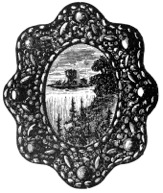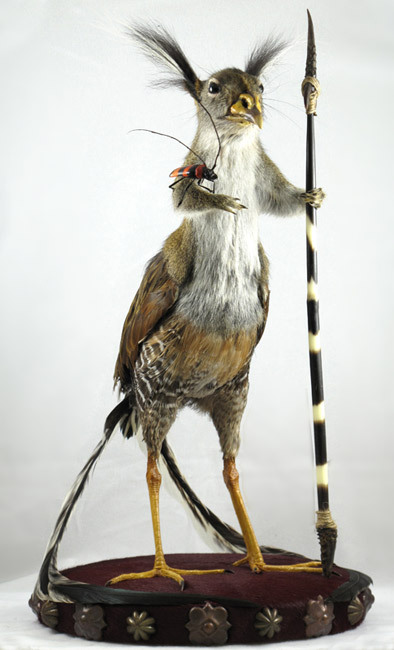Taxidermy has been a particular fascination of mine ever since I was a small child. My family's favorite pizza parlor was covered with nature's lifeless bounty, as was Marsh's Free Museum in Long Beach, Washington, where we had a beach house. With Jake the Alligator Man as a close personal friend, it is no wonder [...]
Viewing: Blog Posts Tagged with: Taxidermy, Most Recent at Top [Help]
Results 1 - 4 of 4
Blog: PowellsBooks.BLOG (Login to Add to MyJacketFlap)
JacketFlap tags: Taxidermy, Nature Studies, Shelf Talkers, Staff Pick, Add a tag
Blog: OUPblog (Login to Add to MyJacketFlap)
JacketFlap tags: recycling, charles dickens, taxidermy, garbage, Humanities, handicraft, *Featured, Cassell’s Household Guide, home making, Novel Craft: Victorian Domestic Handicraft and Nineteenth-Century Fiction, Our Mutual Friend, rubbish, Talia Schaffer, Victorian women, Literature, Add a tag
By Talia Schaffer
Charles Dickens was born 200 years ago this week, but he is very much alive in our culture, having become associated with two ways of seeing the world: “Dickensian” is now shorthand for filthy urban misery, but it is also linked to domestic bliss, the cozy armchair with the rubicund host, the plump goose and the fragrant, steaming punch. The man whose attack on the workhouses has resonated for two centuries is the same man who popularized the modern Christmas.
Interestingly, these two modes are linked by their obsession with (of all things) garbage. The dirt of Victorian London needs no introduction. In Bleak House, the homeless illiterate Jo is a street sweeper, spending his days trying to push back a tide of pestilent mud, horse droppings, ashes, decayed cats. Our Mutual Friend famously centers on three giant mounds of dust. But how was rubbish enshrined in the domestic home?
The answer is that one of the most important values in Victorian domestic organization was the recycling of detritus, and Dickens recognized that. In Our Mutual Friend, the villains steal waste products — they ransack corpses, they try to take the Mounds — but the good characters turn those products into delightful artifacts. Jenny Wren is a dolls’ dressmaker, buying shreds of waste cloth, ribbon ends, and damaged beads, and snipping them into costumes. Mr. Venus articulates skeletons, wiring dusty bones and stray teeth together to make his art.
 Jenny and Mr. Venus are professionals, but their first readers loved them because they are participating in one of the most popular amateur pursuits in the nineteenth century. Victorian domestic handicrafters were urged to glue plum pits to mirrors, to melt leftover candle ends to cover plaster statuettes, to varnish scraps of leather to resemble wood. They exulted in turning household waste into decorative spectacles to prove their managerial skill. In this way, Victorian women could emulate industrial production, making it very different from modern crafts, which embrace an ethos of handmade uniqueness. Just as factories took in raw materials like dead horses or coal, turning out other products, so too did craftswomen process the debris of the home. They had no interest in learning age-old artisanal traditions; rather, they wanted to prove themselves participants in modernity.
Jenny and Mr. Venus are professionals, but their first readers loved them because they are participating in one of the most popular amateur pursuits in the nineteenth century. Victorian domestic handicrafters were urged to glue plum pits to mirrors, to melt leftover candle ends to cover plaster statuettes, to varnish scraps of leather to resemble wood. They exulted in turning household waste into decorative spectacles to prove their managerial skill. In this way, Victorian women could emulate industrial production, making it very different from modern crafts, which embrace an ethos of handmade uniqueness. Just as factories took in raw materials like dead horses or coal, turning out other products, so too did craftswomen process the debris of the home. They had no interest in learning age-old artisanal traditions; rather, they wanted to prove themselves participants in modernity.
For instance, one popular craft involved turning fish scales into homemade sequins: soaking the scales, snipping them with special tiny shears, and piercing them with a needle, before sewing them onto silk. The pleasure in the fish-scale craft came from the creative recycling of trash, and the sense that one could make something as well as a machine did. To churn out identical, swift copies of objects, using premade kits and instructions from mass-circulation magazines and pamphlets, was to reach this ideal.
Handicraft fulfilled other goals, some of them contradictory. Handicraft, for instance, was usually temporary; made of homemade paste and bits of paper, it was designed to fall apart so the maker would have an excuse to bring in something new. For craft was seen as a fashion, to be updated frequently, not as a timeless piece of art.
0 Comments on Charles Dickens and garbage as of 1/1/1900
Blog: DRAWN! (Login to Add to MyJacketFlap)
JacketFlap tags: taxidermy, Enrique Gomez de Molina, sculpture, Add a tag

Amazing impossible taxidermy of fantastical hybrid animals from Enrique Gomez de Molina.
Blog: A Fuse #8 Production (Login to Add to MyJacketFlap)
JacketFlap tags: Uncategorized, Dr. Seuss, Archie, Julius Lester, Grace Lin, Reading is Fundamental, Eric Carle, musicals, National Book Award, Walter Dean Myers, Astrid Lindgren Memorial Award, Allen Say, Jerry Pinkney, Ashley Bryan, Michael Morpurgo, taxidermy, Julie Just, children's literature statues, Anne Pellowski, Ezra Jack Keats Award, Gregory Peck, Jo Osborne Award, Add a tag
 As far as I’m concerned, every good blog post should begin with fiction starring Gregory Peck. What we have here is one of the luscious finds boasted by Greg Hatcher over at the site Comic Book Resources. I’m a big fan of Hatcher because when he does round ups like this one he always takes care to mention a lot of collectible children’s literature. In this post alone you’ll see what the going price is for a good old hardcover Oz or Narnia title, as well as his discovery of Millions of Cats. I remember that when I conducted by Top 100 Picture Books Poll that Millions of Cats was the surprise Top Ten winner. Folks continually forget to give it its due.
As far as I’m concerned, every good blog post should begin with fiction starring Gregory Peck. What we have here is one of the luscious finds boasted by Greg Hatcher over at the site Comic Book Resources. I’m a big fan of Hatcher because when he does round ups like this one he always takes care to mention a lot of collectible children’s literature. In this post alone you’ll see what the going price is for a good old hardcover Oz or Narnia title, as well as his discovery of Millions of Cats. I remember that when I conducted by Top 100 Picture Books Poll that Millions of Cats was the surprise Top Ten winner. Folks continually forget to give it its due.
- Collecting Children’s Books has the usual plethora of wonderfulness up and running for your consideration. First Peter discovers and prints out the complete shortlists of Newbery contenders between the years of 1973-75 (something I wish they still did) and then in a different post considers the state of recent children’s books and whether any of them have been made into Broadway musicals. None that I can think of, since A Year With Frog and Toad isn’t exactly contemporary. Coraline did sort of make it to Broadway a year or so ago (or was that considered off-Broadway?), but that’s the only one I can think of.
- Hey hey! While we were all sleeping the candidates nominated for the Astrid Lindgren Memorial Award were announced. You can see the full list of candidates from countries all over the country here. If I had the time and ability I would familiarize myself with all those names that are unknown to me. On the American side of things, however, here are the USA representatives: Ashley Bryan, Eric Carle, Julius Lester, Grace Lin, Walter Dean Myers, Anne Pellowski, Jerry Pinkney, Reading is Fundamental, and Allen Say. Good luck, guys (and well played Grace for being the youngest). Here’s hoping some of you make it to the final consideration. After all, the Lindgren is the largest monetary award a children’s writer or illustrator can win.
- It was a good week for finalists of all sorts, actually. The National Book Award finalists were released last week and included Paolo Bacigalupi’s Ship Breaker, Kathryn Erskine’s Mockingbird, Laura McNeal’s Dark Water, Walter Dean Myers’ Lockdown, and Rita Williams-Garcia’s One Crazy Summer. How interesting it is to me that non-fiction didn’t make even a sin
7 Comments on Fusenews: Encyclopedia Peck, last added: 10/19/2010Display Comments Add a Comment



Thanks so much for linking to my UK kidlit tour! Yes, the musical Matilda looks wonderful. The songs have been written by Tim Minchin, a very funny and usually quite acerbic comic so I can’t wait to hear how they’ve turned out.
Ah, but there IS a rather comprehensive list of children’s book awards — the Database of Award Winning Children’s Literature (www.dawcl.com) which is kept stunningly up to date by librarian Lisa Bartle. According to the site, “DAWCL has over 8,300 records from 91 awards across six English-speaking countries (United States, Canada, Australia, New Zealand, England, and Ireland). ” Although I will admit that neither the Jo Osborne Award or the Zena Sutherland Award appears in the database, this is still one ding-dang useful resource. (Who knew that the Society of School Librarians International gave out an award?)
Brooke, this link may have seriously improved my quality of life. Thank you! I had absolutely no idea. To the internets!
Here is another taxidermy-related image for your blog! Sophie Blackall’s window case, part of the Drawn in Brooklyn show: http://sophieblackall.blogspot.com/2010/09/drawn-in-brooklyn.html
Brilliant! The mark of the first stuffed penguin. Love the hat. Thanks, Sergio!
Off Broadway seems to be the home of Children’s Books into musicals today “Freckleface Strawberry-The Musical” is playing at the New World Stages of course my favorite musical based on a children’s book has got to be The Secret Garden which actually was on Broadway back in the early 90’s.
I’ll grant the requirement was “recent,” but if someone else brings up “The Secret Garden,” how can I resist? http://www.youtube.com/watch?v=h7_a5nqWC_c